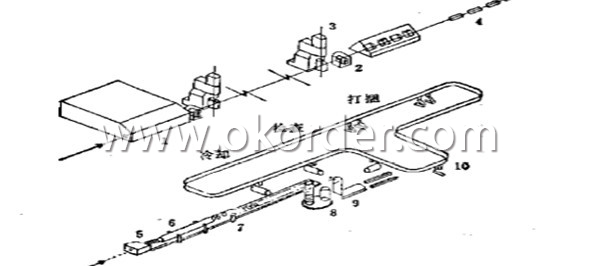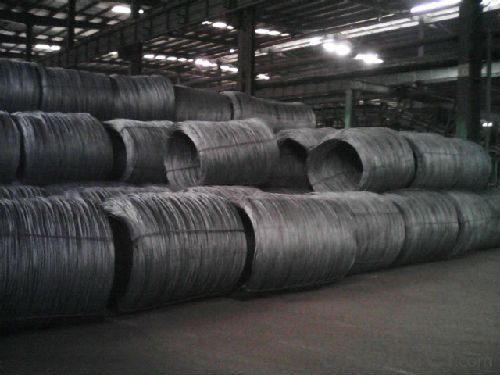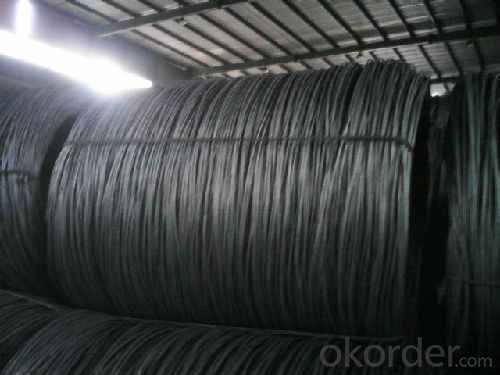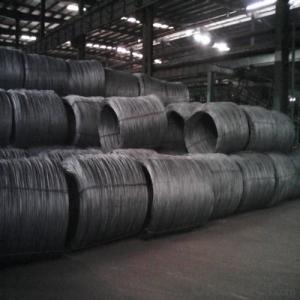Carbon Steel Hot Rolled Wire Rod SAE1008 SAE1006 SAE1018
- Loading Port:
- Tianjin
- Payment Terms:
- TT or LC
- Min Order Qty:
- 50 m.t.
- Supply Capability:
- 40000 m.t./month
OKorder Service Pledge
OKorder Financial Service
You Might Also Like
Product Description:
OKorder is offering Carbon Steel Hot Rolled Wire Rod SAE1008 SAE1006 SAE1018 at great prices with worldwide shipping. Our supplier is a world-class manufacturer of steel, with our products utilized the world over. OKorder annually supplies products to European, North American and Asian markets. We provide quotations within 24 hours of receiving an inquiry and guarantee competitive prices.
Product Applications:
Carbon Steel Hot Rolled Wire Rod SAE1008 SAE1006 SAE1018 are ideal for structural applications and are widely used in the construction of buildings and bridges, and the manufacturing, petrochemical, and transportation industries.
Product Advantages:
OKorder's Carbon Steel Hot Rolled Wire Rod SAE1008 SAE1006 SAE1018 are durable, strong, and resist corrosion.
Main Product Features:
· Premium quality
· Prompt delivery & seaworthy packing (30 days after receiving deposit)
· Corrosion resistance
· Can be recycled and reused
· Mill test certification
· Professional Service
· Competitive pricing
Product Specifications:
Specifications of Wire Rod SAE1008B:
Steel Grade: SAE1008B Standard: ASTM, GB
Diameter: 5.5mm, 6.5mm, 7mm,8mm,9mm,10mm,12mm,14mm
Type: Drawn Wire Alloy or Not: Alloy Brand Name: N-RIVER
Technique: Hot Rolled Place of Origin: China Mainland
Chemical Composition:
Please kindly find our chemistry of our material based on SAE1008B as below for your information
Grade | Chemical Composition (%) | |||||
C | Mn | S | P | Si | B | |
SAE1008B | 0.10max | 0.32max | 0.045max | 0.040max | 0.30max | 0.0008min |
Mechanical properties | ||||||
Yield strength(N/mm2) | Tensile strength(N/mm2) | Elongation (%) | ||||
≥195 | 350-380 | ≥32 | ||||
Usage and Applications of Wire Rod SAE1008B:
After hot-rolled the products shaped into coil and delivery as finished product, including round, square, rectangular, hexagonal and so on. Since most of the products are round, it is generally called wire rod. Carbon steel wire rod is widely used in construction and manufacturing. Carbon steel wire rod is mainly used for reinforcement of reinforced concrete and welded structure or reprocessed (roberts , nail, etc.) materials, especially used to produce wire drawing, welding electrode, nails, spring, electronic, precise machinery parts and so on.
Production Process of Wire Rod SAE1008B:

1-Furnace 2-Roughing Mill 3-High-speed Finishing Mill 4-Water-cooled Device 5-Coiling Device
6-Cooling Device 7-Chain Conveyer 8-Spool Collecting Device 9-Spool Down Device 10-Hook Conveyer
Packaging & Delivery of Wire Rod SAE1008B:
Packaging Detail: products are packed in coil and then shipped by container or bulk vessel
Each coil weight: 2-3MT
Delivery Detail: within 45 days after received deposit or LC.
Label: to be specified by customer, generally, each bundle has 1-2 labels
Trade terms: CFR, CIF
Note:
1. Our products are produced according to national standard (GB), if not, supply according to national standards (GB) or agreement as customer required.
2. Other Grade and Standard carbon steel wire rod we can supply:
Grade: H08A, 30MnSi, 62B-82B
Standard: AISI, BS, JIS, DIN
The Minimum Order Quantity of these products is high, and need to be confirmed.
3. We can not only supply carbon steel wire rod; if you need anything about building materials, please contact us.
4. Please send us your detail specifications when inquire. We will reply to you as soon as possible. We sincerely hope we can establish a long stable business relationship.
FAQ:
Q1: Why buy Materials & Equipment from OKorder.com?
A1: All products offered byOKorder.com are carefully selected from China's most reliable manufacturing enterprises. Through its ISO certifications, OKorder.com adheres to the highest standards and a commitment to supply chain safety and customer satisfaction.
Q2: How do we guarantee the quality of our products?
A2: We have established an advanced quality management system which conducts strict quality tests at every step, from raw materials to the final product. At the same time, we provide extensive follow-up service assurances as required.
Q3: How soon can we receive the product after purchase?
A3: Within three days of placing an order, we will begin production. The specific shipping date is dependent upon international and government factors, but is typically 7 to 10 workdays.
Q4: What makes stainless steel stainless?
A4: Stainless steel must contain at least 10.5 % chromium. It is this element that reacts with the oxygen in the air to form a complex chrome-oxide surface layer that is invisible but strong enough to prevent further oxygen from "staining" (rusting) the surface. Higher levels of chromium and the addition of other alloying elements such as nickel and molybdenum enhance this surface layer and improve the corrosion resistance of the stainless material.
Q5: Can stainless steel rust?
A5: Stainless does not "rust" as you think of regular steel rusting with a red oxide on the surface that flakes off. If you see red rust it is probably due to some iron particles that have contaminated the surface of the stainless steel and it is these iron particles that are rusting. Look at the source of the rusting and see if you can remove it from the surface.
Images:



- Q:What is the pricing structure of steel wire rod?
- The pricing structure of steel wire rod is typically determined by various factors such as the current market demand and supply, production costs, quality and specifications of the wire rod, and competitive pricing strategies of the manufacturers. It is subject to fluctuations due to changes in raw material prices, global economic conditions, and trade policies. Therefore, the pricing structure can vary from time to time and between different suppliers and regions.
- Q:What are the different surface marking materials used for steel wire rod?
- The different surface marking materials used for steel wire rod include paint, ink, and laser marking.
- Q:How does the fatigue strength of steel wire rod vary with different wire drawing processes?
- The fatigue strength of steel wire rod can vary depending on the specific wire drawing process used. Wire drawing is a metalworking process that involves pulling a metal wire through a die to reduce its diameter and increase its length. There are various wire drawing processes, such as wet drawing, dry drawing, and intermediate drawing, each with unique characteristics and effects on the fatigue strength of the steel wire rod. One factor that affects the fatigue strength is the lubrication used during the wire drawing process. Wet drawing involves immersing the wire rod in a lubricant to reduce friction and heat generation. This lubrication helps in reducing the chances of surface defects and improves the fatigue strength of the wire rod. On the other hand, dry drawing does not involve any lubrication, which can result in increased friction and heat generation, potentially leading to a decrease in fatigue strength. The reduction ratio, which is the ratio of the initial wire diameter to the final wire diameter, also plays a crucial role. Higher reduction ratios can lead to an increase in the fatigue strength of the wire rod as the process aligns the grain structure and improves the overall mechanical properties. However, excessively high reduction ratios can introduce internal defects or residual stresses, which can negatively impact the fatigue strength. The heat treatment process after wire drawing can significantly influence the fatigue strength as well. Heat treatment techniques, such as annealing or quenching, can enhance the microstructure of the wire rod and improve its fatigue strength. Annealing helps in relieving internal stresses and refining the grain structure, while quenching provides increased hardness and strength. These heat treatment processes can compensate for any potential reduction in fatigue strength caused by the wire drawing process. In summary, the fatigue strength of steel wire rod can vary with different wire drawing processes. Factors such as lubrication, reduction ratio, and heat treatment techniques can all influence the fatigue strength. It is essential to carefully select the appropriate wire drawing process and associated parameters to optimize the fatigue strength of the steel wire rod for specific applications.
- Q:How is steel wire rod used in the manufacturing of wire baskets for industrial applications?
- Steel wire rod is an essential raw material used in the manufacturing of wire baskets for industrial applications. The wire rod serves as the base material from which the wire baskets are formed. To begin the manufacturing process, the steel wire rod is first carefully selected and inspected for its quality and specifications. It is important for the wire rod to have the desired strength, flexibility, and durability required for industrial applications. Once the wire rod meets the necessary standards, it is then subjected to various processes to transform it into wire baskets. The first step in the manufacturing process involves drawing the steel wire rod through a series of dies to reduce its diameter and increase its length. This process is known as wire drawing. The wire drawing process helps in improving the wire rod's surface finish, strength, and dimensional accuracy. After wire drawing, the steel wire rod is then further processed through various techniques such as annealing, cleaning, and coating. Annealing helps to relieve any internal stresses in the wire and enhance its ductility, making it easier to form into wire baskets. Cleaning removes any impurities or contaminants from the wire rod's surface, ensuring a clean and smooth finish. Coating involves applying a protective layer on the wire rod to prevent corrosion and enhance its durability. Once the wire rod is prepared, it is ready to be formed into wire baskets. The wire rod is fed into a machine called a wire basket forming machine, where it is bent, twisted, and shaped into the desired basket design. The machine uses various mechanisms, such as rollers and dies, to mold the wire rod into the required shape and size. After the wire rod has been formed into wire baskets, they undergo further processes such as welding, cutting, and finishing. Welding is used to join the different sections of the wire basket together, ensuring its structural integrity. Cutting is performed to trim any excess wire and achieve the desired dimensions. Finally, the wire baskets are finished by removing any sharp edges, polishing the surface, and applying any required surface treatment or coating. In summary, steel wire rod plays a crucial role in the manufacturing of wire baskets for industrial applications. It serves as the primary material from which the wire baskets are formed, and its properties are vital in determining the strength, durability, and overall quality of the final product. Through a series of processes, the wire rod is transformed into wire baskets, which are then used in various industrial applications such as storage, transportation, and organization of goods.
- Q:How is steel wire rod used in the manufacturing of wire screens?
- Steel wire rod is used in the manufacturing of wire screens as the primary raw material. It is first drawn through a series of dies to reduce its diameter and increase its length, resulting in a smooth and uniform wire. This wire is then woven or welded together to create wire screens, which are commonly used in various industries for filtration, screening, and protection purposes. The strength and durability of steel wire rod make it particularly suitable for withstanding heavy loads and harsh environments, ensuring the longevity and effectiveness of wire screens.
- Q:What is the typical diameter range of steel wire rod?
- The typical diameter range of steel wire rod is between 5.5mm to 20mm.
- Q:How is steel wire rod straightened and cut to length?
- The process of straightening and cutting steel wire rod, known as straightening and cutting, involves the use of a machine. This machine, referred to as a straightening machine, aids in the elimination of any bends or twists in the wire rod by feeding it through a series of rollers that exert pressure and gradually straighten it. Once the wire rod is straightened, it is then passed through a cutting machine that is specifically designed to cut through steel wire rods. This cutting machine is equipped with a blade or cutting tool and allows for the rod to be cut into the desired lengths. The length is determined by setting the desired length on the machine. The straightening and cutting process can be carried out either automatically or manually, depending on the scale of production. In automated systems, the wire rod is fed into the straightening and cutting machines through mechanisms such as conveyor belts. The desired length is set on a control panel, and the machines automatically straighten and cut the rod accordingly. For smaller scale operations, manual straightening and cutting are commonly employed. In this case, an operator manually feeds the wire rod into the straightening machine and then uses a cutting tool to manually cut it to the desired length. This process requires skill and precision to ensure accurate and precise straightening and cutting. Overall, the process of straightening and cutting steel wire rods is crucial in manufacturing precise lengths and straightness. It plays a vital role in industries such as construction, automotive, and manufacturing, where steel wire rods are utilized in various applications.
- Q:How is steel wire rod recycled in a steel production facility?
- In a steel production facility, the recycling process of steel wire rods involves several steps to ensure efficient and sustainable reuse of this material. Here is a breakdown of the steel wire rod recycling process: 1. Collection and Sorting: The first step is to collect steel wire rods from various sources, such as scrap yards, demolition sites, or manufacturing plants. These steel wire rods are then sorted based on their quality and composition. Sorting allows for better control over the recycling process and ensures that only suitable materials are used. 2. Shredding and Fragmentation: Once sorted, steel wire rods go through a shredding process, which involves passing them through heavy-duty machines that break them down into smaller pieces. This fragmentation increases the surface area of the material, making it easier to handle during subsequent steps. 3. Magnetic Separation: After shredding, the fragmented steel wire rods undergo magnetic separation. Powerful magnets are used to extract any ferrous materials, such as iron and steel, from the mixture. This process effectively removes any impurities and contaminants, leaving behind clean steel wire rods. 4. Melting and Purification: The clean steel wire rods are then melted in a furnace at extremely high temperatures. This process, known as smelting, turns the solid fragments into molten steel. During the melting process, various additives and chemicals can be introduced to refine the steel's composition and properties. 5. Casting and Solidification: Once the steel has been melted and purified, it is cast into molds to form new steel products or billets. These molds can be customized based on the desired shape and size of the final product. The molten steel is poured into the molds and left to cool and solidify. 6. Rolling and Drawing: After solidification, the steel billets are subjected to rolling mills that progressively reduce their size and shape them into the desired final product, such as wire rods, bars, or sheets. Depending on the specific requirements, the steel may also undergo a drawing process, where it is pulled through a series of dies to achieve the desired diameter and shape. 7. Quality Control and Finishing: Before the final product is ready, it undergoes rigorous quality control inspections to ensure it meets the required specifications and standards. Any defects or imperfections are identified and corrected. Once approved, the steel wire rods are typically cleaned, coated, or treated to enhance their durability, corrosion resistance, or other desired properties. Overall, the recycling process of steel wire rods in a steel production facility involves collection, sorting, shredding, magnetic separation, melting, casting, rolling, quality control, and finishing. This comprehensive process ensures that steel wire rods are effectively recycled, reducing the need for virgin materials and promoting sustainability within the steel industry.
- Q:How is steel wire rod used in the production of wire mesh for oil and gas filtration?
- Steel wire rod is used as the primary material in the production of wire mesh for oil and gas filtration. The wire rod undergoes a series of processes, including drawing, annealing, and coating, to enhance its strength and corrosion resistance. Once transformed into wire, it is woven or welded to create a mesh structure that effectively filters out impurities and contaminants from oil and gas. The resulting wire mesh is durable, efficient, and capable of withstanding high temperatures and harsh operating conditions, making it a vital component in oil and gas filtration systems.
- Q:What are the different methods of joining steel wire rod?
- There are several methods of joining steel wire rods, each with its own advantages and disadvantages. Some of the most common methods include welding, soldering, brazing, and mechanical joining. 1. Welding: This is the most popular method for joining steel wire rods. It involves melting the ends of the rods together using high temperatures and filling the gap with a molten filler metal. Welding provides a strong and permanent bond, but it requires skilled labor and specialized equipment. 2. Soldering: Soldering is a process that uses a lower melting point filler metal, known as solder, to join the steel wire rods. It is commonly used for smaller diameter wires and provides a relatively strong joint. However, soldered joints may not be as strong as welded joints and can be affected by high temperatures. 3. Brazing: Similar to soldering, brazing uses a filler metal with a higher melting point to join the steel wire rods. The filler metal is heated to its melting point, but below the melting point of the base metal, and then allowed to flow between the rods. Brazing offers a stronger joint than soldering and can be used for higher temperature applications. 4. Mechanical joining: This method involves mechanically connecting the steel wire rods without the use of heat or filler metals. Various mechanical joining techniques such as crimping, swaging, or using nuts and bolts can be employed. Mechanical joining is often easier and faster than other methods, but it may not provide the same level of strength or permanence. It is important to consider the specific requirements of the application, such as strength, temperature resistance, and ease of assembly, when choosing the appropriate method for joining steel wire rods. Additionally, factors such as cost, availability of equipment, and expertise required should also be taken into account.
1. Manufacturer Overview |
|
|---|---|
| Location | |
| Year Established | |
| Annual Output Value | |
| Main Markets | |
| Company Certifications | |
2. Manufacturer Certificates |
|
|---|---|
| a) Certification Name | |
| Range | |
| Reference | |
| Validity Period | |
3. Manufacturer Capability |
|
|---|---|
| a)Trade Capacity | |
| Nearest Port | |
| Export Percentage | |
| No.of Employees in Trade Department | |
| Language Spoken: | |
| b)Factory Information | |
| Factory Size: | |
| No. of Production Lines | |
| Contract Manufacturing | |
| Product Price Range | |
Send your message to us
Carbon Steel Hot Rolled Wire Rod SAE1008 SAE1006 SAE1018
- Loading Port:
- Tianjin
- Payment Terms:
- TT or LC
- Min Order Qty:
- 50 m.t.
- Supply Capability:
- 40000 m.t./month
OKorder Service Pledge
OKorder Financial Service
Similar products
New products
Hot products
Related keywords



























